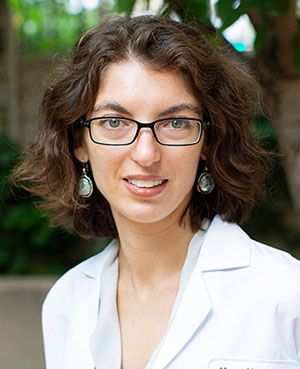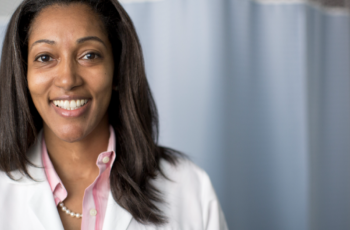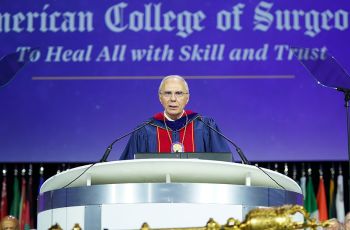
In the midst of the COVID-19 pandemic, one persistent issue has emerged: Long COVID syndrome. About 10 to 30% of people diagnosed with COVID-19 suffer from lingering symptoms months after being infected. The George Washington University (GW) Medical Faculty Associates (MFA), however, is doing its best to help. Every week, the MFA hosts a clinic, with a goal of customizing treatment plans for each patient. Hana Akselrod, MD, MPH, an infectious disease physician with the MFA and assistant professor of medicine at the GW School of Medicine and Health Sciences, explains what Long COVID is, how the GW MFA is supporting patients, and what the future holds for treatment.
Q: What is Post-Acute Sequelae of COVID (PASC), otherwise known as Long COVID, and what are the symptoms?
Akselrod: One of the more common definitions for PASC is having substantial symptoms more than 10 weeks, or two months, after initial diagnosis. The symptoms themselves vary. Some people experience significant respiratory problems or are unable to tolerate exercise or exertion. Others have nerve pain, persistent headaches, trouble concentrating, or memory problems, which have been described as a kind of brain fog. And then some people tend to get fevers, muscle aches, and inflammation-like symptoms.
Q: Do you know why some people, but not others, develop Long COVID?
Akselrod: There’s no single patient profile because this is a new clinical entity that we’re figuring out collectively. However, there are areas of overlap with other post-infectious syndromes. A minority of people who have an acute viral infection or Lyme disease, for example, may develop inflammatory or painful changes that persist for a long time after the initial illness. The pathogen that triggered this is gone, but the inflammation or the symptoms persist. We do not know yet if there are certain genetic or environmental factors that may be predisposed to these phenomena. We do know that Long COVID is not limited to a single demographic group in the U.S. and is also reported in other countries.
Q: How has GW responded to help these patients here?
Akselrod: We have launched a clinic dedicated to patients with post-acute symptoms after COVID. This includes both people who were severely ill in the hospital and have had a difficult time recovering, as well as those whose initial symptoms were not severe but who developed prolonged symptoms afterward. In speaking with leaders of similar clinics in other academic medical centers across the country, we have a shared impression that we are dealing with a real clinical syndrome that we do not fully understand. However, we hope to come out of this pandemic with a better understanding of the immune system and what can happen to it in response to certain infections.
We’re trying to be very thoughtful about how, in the months to come, we can make the clinic more accessible and equitable, and better understand who in the greater Washington, D.C., area is affected. Additionally, we have been developing scientific research protocols to help shed light on the mechanisms of disease and identify strategies for diagnosis and treatment.
Q: How many patients have you seen since you opened the clinic?
Akselrod: We have seen more than 100 patients since October 2020. The clinic is at full capacity right now, and we are in the process of adding more slots and training additional providers to help meet the need after the wave of new infections this winter. The patients have been tremendous advocates for themselves, organizing and sharing resources and approaches on social media outlets.
The clinic experience has at times been very emotional. Some patients who have been symptomatic since early in the pandemic have shared their struggles to find physicians able to listen and acknowledge what was happening to them, and then try to make sense of it clinically and scientifically. Being alone, isolated, and still suffering months later has added to the trauma for many people. Knowing that the medical profession sees you and is working to get you better can be really helpful.
Q: What can you do to help these patients?
Akselrod: First, we do a comprehensive medical evaluation — understand who the patient is and what they’ve been through — and then try to identify specific types of organ damage or an ongoing disease process, which would then be actionable or treatable.
For example, we know that in some patients, COVID-19 can cause myocarditis or damage to the heart muscle, can trigger cardiac events like a heart attack or heart failure, or can trigger reactive airway disease like bronchitis. In that case, we can target and treat those conditions with specific medications. We also get a sense of where people are in terms of their physical and mental function and their ability to tolerate exertion.
We then work with cardiology, pulmonology, neurology, and physical medicine and rehabilitation colleagues to create a tailored approach for the patient. We know that people do better with guided and staged recovery plans. Physical therapy and occupational therapy, in particular, have played a huge role with exercises that are safe and can be built up to restore physical endurance over time. The GW Memory Clinic and cognitive rehabilitation are also important in our model.
We try to understand what role mental health and stress management play in recovery. It is difficult for people to feel their best emotionally if they’re struggling to breathe or walk, but anxiety and stress can also exacerbate the physical suffering. We need a multidisciplinary approach to treat medical complications, improve physical performance, and better manage stress and emotional wellness in parallel.
Q: How significant of a public health threat is Long COVID syndrome?
Akselrod: I think this is huge. We simply do not know yet what effects COVID may have in the long run on the risk for cardiac disease, the loss of the ability to work, and the burden of mental illness. We know there is not nearly enough availability right now of clinics like ours compared to the number of people struggling to recover from COVID-19 and that people who were at the highest risk to get sick, such as essential workers and minority populations, already had a harder time getting good medical care before the pandemic. The public health burden of all this is very significant, very real.
There are also reasons for hope. Over the years, our medical system has gotten better at managing patients with chronic illness, helping people live with heart failure, chronic lung disease, or kidney failure. As an infectious disease physician today, I help people with HIV infection live a full and healthy life. But it took decades of work by patients, advocates, and physicians to get there. I believe there are strategies we can adapt from other conditions to help patients with long-term symptoms after COVID-19. The multidisciplinary model, in which we put the patient and their needs in the middle and organize different medical professionals around them, is inspired by these experiences. That can be a very powerful approach.



